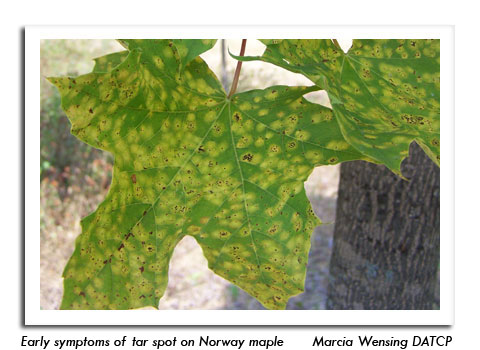
 |
|
|
Nursery & Forest
Volume 60 Number 8 Date 06/11/2015 SPECKLED GREEN FRUITWORM - Larvae of the speckled species were found to be the cause of moderate to severe defoliation of linden trees in Monroe and Richland counties. Both this species and the humped green fruitworm are particularly abundant this season and have been observed on a variety of trees and shrubs (apple, ash, elm, euonymus, hackberry, maple, oak, peony, rose, serviceberry and spruce), according to the UW-Madison Insect Diagnostic Lab. PINE SPITTLEBUG - Scotch pines at a nursery stock retailer location in Burnett County were heavily infested with this insect, easily recognized by its frothy, white spittle masses which provide protection for developing nymphs. The pine spittlebug infests conifers of all sizes, causing discoloration of branch tips. Eastern white pine, jack pine and Scotch pines are the preferred hosts. Although this pest is generally only an aesthetic problem, treatment may be warranted in rare high-population situations. Applications of an appropriate insecticide should be made in late May and early June when the spittle masses are first noticed. The adults can also be targeted around mid-July, after 90% of the spittle masses have been vacated. AMBROSIA BEETLE - Damage to horse chestnut trees by an unidentified ambrosia beetle species was observed at a garden center in Green County. The inspector who found the infestation was unable to determine if the species involved was native or exotic. Native ambrosia beetles prefer stressed and weakened trees, while non-native species attack both stressed and healthy trees. Evidence of ambrosia beetle infestation is very distinctive and appears as toothpick-like tubes of frass projecting from the tree trunk. Fungal staining from symbiotic fungi is often noticeable in the wood tissues surrounding the beetle's galleries. DATCP regulations require trees infested with these aggressive, destructive beetles to be removed from sale and destroyed. APHID PREDATOR MIDGE - This beneficial, aphid-eating insect was found on birchleaf spirea 'Glow Girl' in Washington County. The larvae feed on over 70 aphid species, making them a popular biological control agent in greenhouses. The orange maggot-like larvae feed primarily at night and remain hidden on the undersides of leaves by day. Adult midges feed on aphid honeydew and deposit eggs in aphid colonies. There are three to six generations per year. TAR SPOT - The pale yellow lesions appearing on maples in Dane, Grant and Rock counties are early symptoms of tar spot, a cosmetic fungal leaf spot disease. Infected foliage will soon develop raised, black, tar-like spots and severely diseased leaves may drop prematurely. Tar spot is an aesthetic disorder best controlled by clearing and destroying infected leaves in fall to prevent the spores from spreading. If treatment is justified, three fungicide applications are necessary for control: one at bud break, one when leaves are half expanded, and one when leaves are fully expanded. COLD INJURY/WINTER BURN - DATCP inspectors continue to find numerous trees and shrubs exhibiting symptoms of cold injury and winter burn. Nursery stock that was not properly overwintered commonly develops severe branch dieback or brownish, burned needles. Trees and shrubs with winter injury should be monitored for new growth and pruned before being returned to sale. Severely damaged plants should not be sold. -- Ellen Hermanson, DATCP Nursery Inspector EMERALD ASH BORER - Adults are emerging across the southern two-thirds of Wisconsin and were observed on June 8 in Dane County. Beetle emergence typically begins when the black locust tree is in full bloom, or around 450 growing degree days (base 50°F). Degree day accumulations as far north as Crandon in Marinette County are beyond this threshold and most confirmed infestations in the state are experiencing initial beetle flight this week. Emerald ash borer adults can be observed feeding on ash leaves, on the bark of the main stem, or in the vicinity of ash trees. The metallic green beetles differ from similar green beetles by having a purple-red abdomen which is visible during flight. -- Renee Pinski, DATCP Forest Entomologist GYPSY MOTH - Bacillus thuringiensis var. kurstaki (Btk) treatments were applied June 9 to approximately 1,540 acres in Bayfield and Douglas counties, marking the completion of all Btk spraying in the state for the 2015 season. Mating disruption, or pheromone flake treatment, is scheduled to begin before the end of June, with the bulk of treatments to be completed in July. Pheromone flakes reduce population levels by preventing gypsy moths from mating. Larval development has advanced to the sixth instar stage as far north as the Eau Claire area, while larvae in the second instar are still present in the northern counties. The annual trapping survey is now 55% complete, with 6,562 of the expected 12,000 traps set as of June 10. All pheromone traps intended for Clark, Columbia, Dodge, Green, Lincoln, Marathon, Marquette, Milwaukee, Pierce, Taylor, Waukesha and Wood counties have been set. The remaining 45% of traps should be in place by the first week of July. -- Rick Hummell, DATCP Gypsy Moth Program 





|
|
|